Rooms "under the eaves" exude a cosy, comfortable character, but the downside is a loss of space and storage. Wallpapers, colours and furniture need to be thought about in a bit more depth in order to create the best possible environment and a sense of well-being.
Contrary to the widespread opinion that sloping ceilings are problem zones, they actually provide a huge amount of creative potential. This creative potential can be exploited fully by using beautiful design wallpaper, as this guide blog will show. Wallpapering sloping ceilings isn't rocket science either; you just need a little bit of patience and time when you first try it. Armed with our tips and tricks, you can tackle it with confidence.
Not all sloping ceilings are the same
In order to choose the right wallpaper for sloping ceilings, the first consideration is whether more than one is present in the room. If the roof, or the attic/top floor, is converted, there will be two slopes and two gable walls facing each other. There will be a low straight wall area (or none at all) which is called a knee wall, jamb wall or flap tile. Alternatively, the room might just have one sloping ceiling including a jamb wall of about 80 cm. The remaining walls will then be straight.
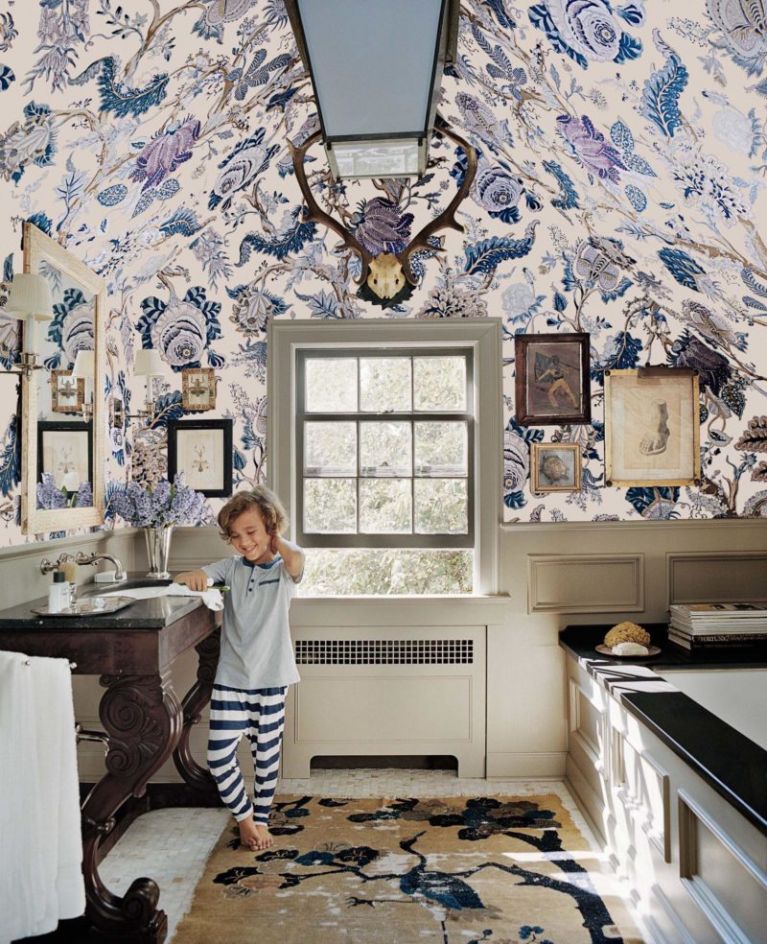
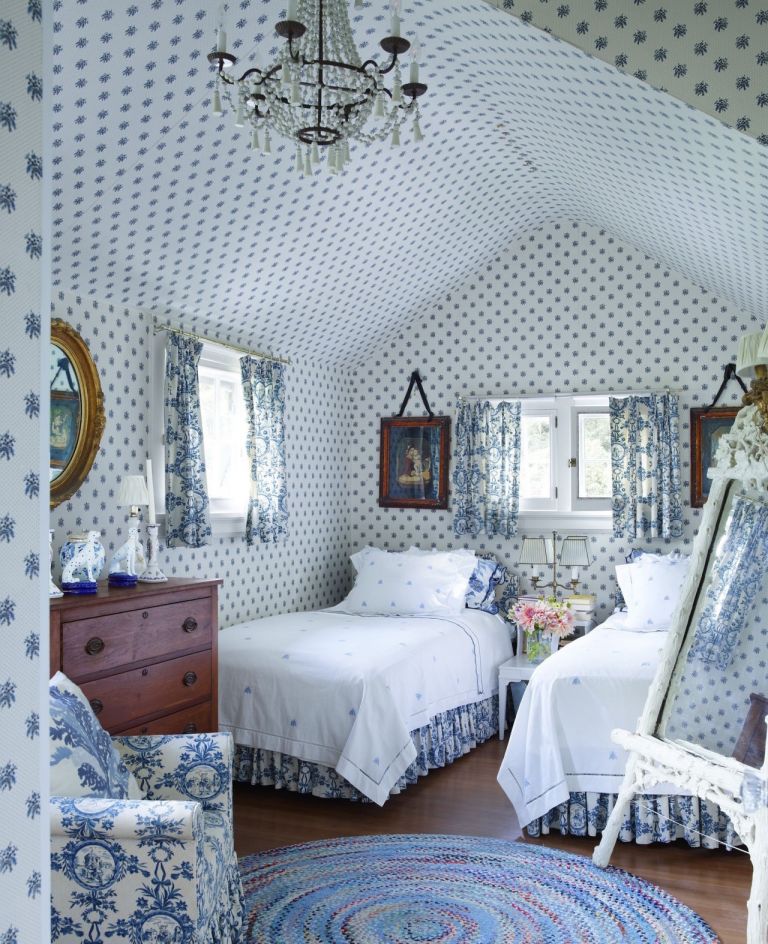
Sloping ceilings can have a number of different roof pitches/angles. The steeper the slope, the higher the roof pitch, and the further the slope will "protrude" into the room.
Plan first, choose your wallpaper later
Slanting ceilings have huge potential for imaginative and stylish rooms with a double dose of charm. Before selecting a wallpaper model, the interior design concept for the room should be finalised.
The room layout should be used intelligently and the proportions should harmonise with the envisaged furniture. Another important aspect is the freedom of movement in the space. Are there clear structures and paths? How is the slope integrated into the concept? Will there be furniture or will this area be relatively empty? Is it a central focal point, for instance if a bed is placed under the sloping ceiling? The number, type and position of windows (skylights, dormer, vertical windows, balcony doors) also need to be taken into account. These considerations will have a significant impact on the choice of patterns, colours and effects of wallpapers.

Patterned wallpapers for sloping ceilings
Thematically, there are very few limits. For example, you can choose romantic floral patterns, geometric or graphic designs, baroque patterns and many other unusual motifs. The size, positioning and effects of the patterns have a major impact on the ambience of a room:
- Large-scale, wide or horizontal patterns make the sloping ceiling look shorter, visually reduce the height of the room and generally make the space appear smaller.
- More delicate, narrow and vertical patterns make the room look bigger, higher and wider.
- Multi-dimensional or sculptural patterns and optical effect patterns often found in graphical ad geometric models are not suited for areas around skylights and dormers. They create a less-than-calm atmosphere. If there is more than one window in the sloped ceiling, patterned wallpapers should be avoided altogether.
- Optical illusion effects created by pattern arrangements, colours, structures and special finishes look very different on a straight wall than on a slope. Depending on how the light hits the wall, there might also be a glare effect. It's useful to get some pattern samples and check for these possible issues in situ.
- Wallpapers in a wood or stone look present sloping ceilings in a naturally urban design and are a real eye-catcher. They draw the eye to the slanting ceiling, but at the same time integrate it into the general room concept.
- In children's rooms with slopes, it should be considered whether the wallpaper is merely a decorative element or if is also meant to invite the child(ren) to play. If the wallpaper is meant to be part of playtime, it makes sense - for practical reasons - to not use it for sloped walls.
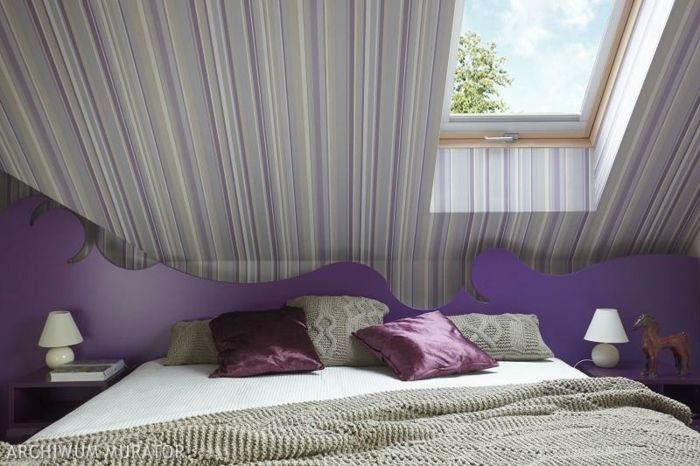
Wallpaper colours for sloping ceilings
Light or dark colours, muted or bright, pastel or natural - generally speaking, anything goes in rooms with sloped ceilings. The natural light efficiency of any windows has a significant role to play. Sloping walls should never be seen as a separate element though - the combination of colours throughout the room has to create a harmonious picture. If you choose dark or stronger colours for the slope, a lighter contrast colour is needed for the other walls in order to avoid a heavy or dark ambience. Contrast is the magic word for all rooms with slanting ceilings. It can come in subtle gradations, dark-light or tone-in-tone colour contrasts.
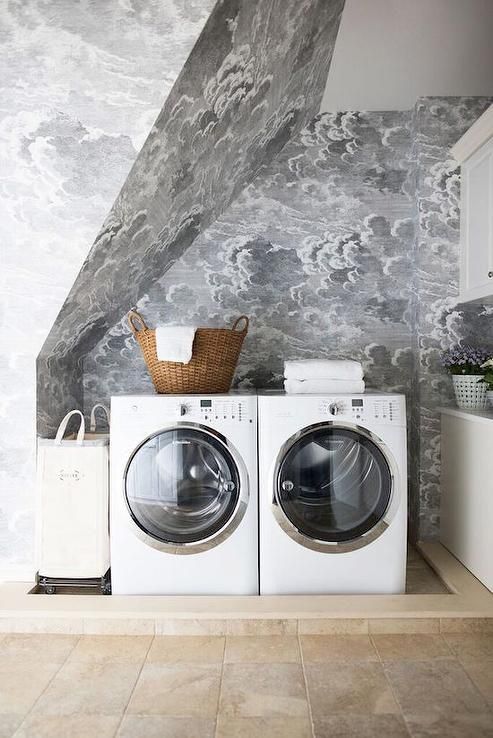

Carrier and surface materials
There are two types of carrier materials: fleece (also known as non-woven) or paper-based wallpapers. Fleece wallpapers are the easier option for sloped ceilings. They can be set onto the paste bed, i.e. directly on the wall, which makes the whole process a lot easier. For paper-based wallpapers, the paste needs to be applied to the back of the wallpaper and soak in for a specific time before it can be put up on the wall. They are significantly heavier when damp, and there is also an increased risk of damage when they are hung.
Design wallpapers are characterised by special patterns, embossings and structures as well as exclusive surfaces made from natural materials, textiles, metal or effect foils, or adorned with sparkling glass beads. These wallpapers are all suitable for sloped ceilings, too. Beautiful grass, bamboo, flock and crush wallpapers or models with glass beads turn the slope into a fascinating centrepoint. For wet rooms with slopes, e.g. bathrooms or kitchens, moisture-proof wallpaper with a sealed surface (e.g. vinyl wallpapers) should be used.
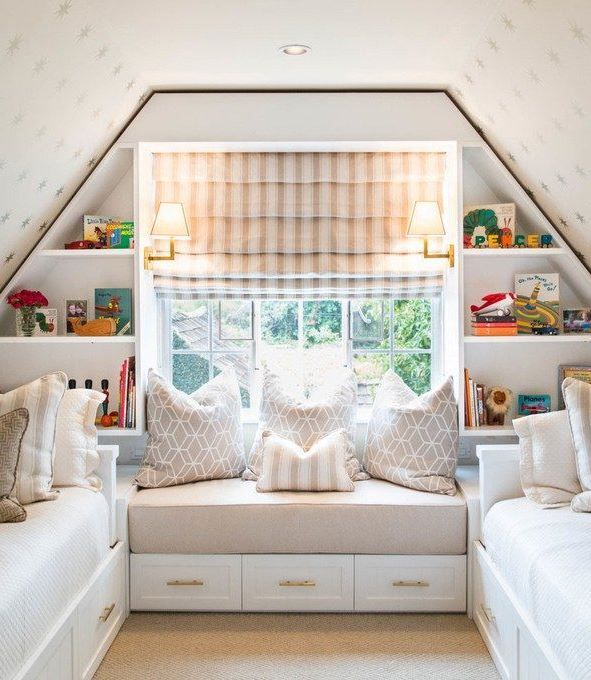
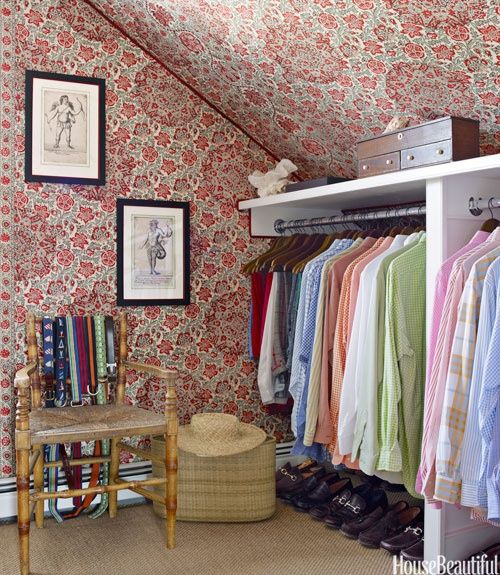
Should rooms with sloped ceilings be reduced to just one wallpaper design?
Walls with slopes that have a high knee wall can be wallpapered with the same wall decoy as straight vertical walls, for this creates a neutral effect. The slope is simply integrated in the design and has no changing effect on the room. This type of unified design is particularly pleasant in rooms with a country house flair, a romantic touch or in a Shabby Chic style, but it should be noted that small patterns are preferable. Large patterns, visual effects, bright or dark colours are definitely not suitable as they tend to be overwhelming and have an unnerving effect. In order to change the impact of slopes with high knee walls, the wallpaper chosen should differ from that for the rest of the room. Find some useful hints and tips further down in this guide.
For rooms with two slopes, a unified design for slopes and gable walls is the best option. This is particularly true for wallpapers in stunning wood or stone imitation looks. Due to their special structures, nature and textile wallpapers create an ambience of well-being and comfort.
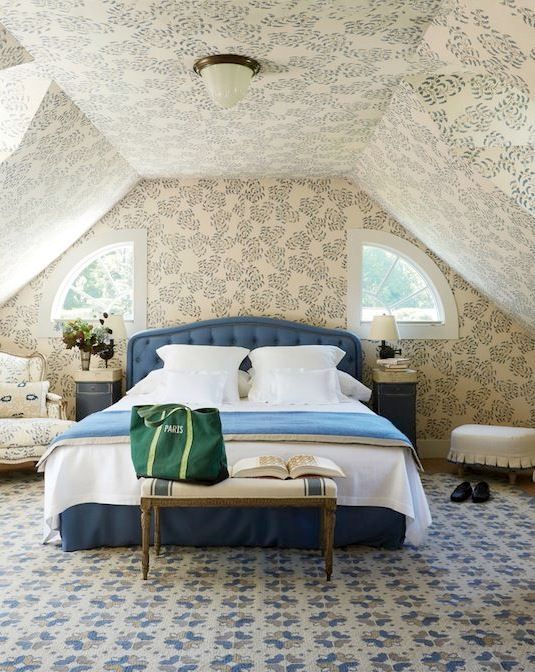
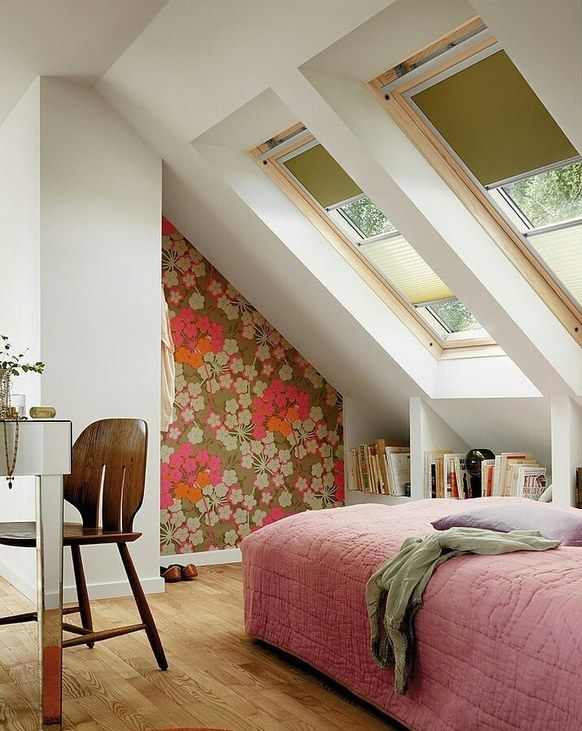
Wallpaper ideas for rooms with one slope (top floor)
Sloping ceilings are often seen in their pure simplicity and treated accordingly. However, it is worth thinking outside the box to discover unique design options for those areas. By changing the visual appearance of a slope, it can create a completely new perspective. Here are some interesting options:
The same wallpaper design for both slope and ceiling
A room with a sloping ceiling can be re-structured by continuing the pattern or design wallpaper on the ceiling. This adds movement and depth to a room. Use stripes, dots, floral, Baroque, Art Nouveau or Art Deco patterns. Wallpapers in imitation wood or stone designs as well as special materials like grass, cork, and flock are also suitable.
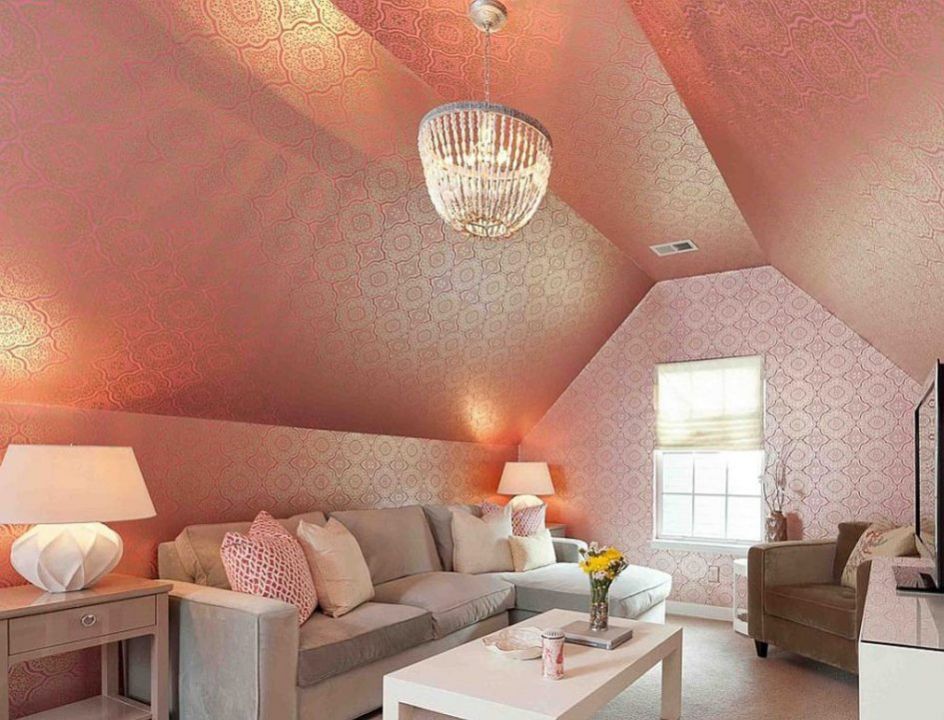
For those who like a bit of glamour, there are gloriously sparkly glass bead wallpapers, which conveniently create their very own starry sky. Metal and effect foil wallpapers are also a good match for this interior design concept, but bear in mind that wallpapering will take a bit more time and effort.
Dividing the sloping ceiling is another option of presenting it in a new way. The most popular and common way to do this is the classic division into two parts. Sloped and straight wall areas are presented in different guises. Patterned wallpapers can be combined with simple one-coloured models, but imitation stone or wood wallpapers are also very effective as a contrast. The most important consideration is whether the patterns and colours match; structures and materials should also present a harmonious picture. A wallpaper paper border or dado rail can help to cleverly connect the two areas.
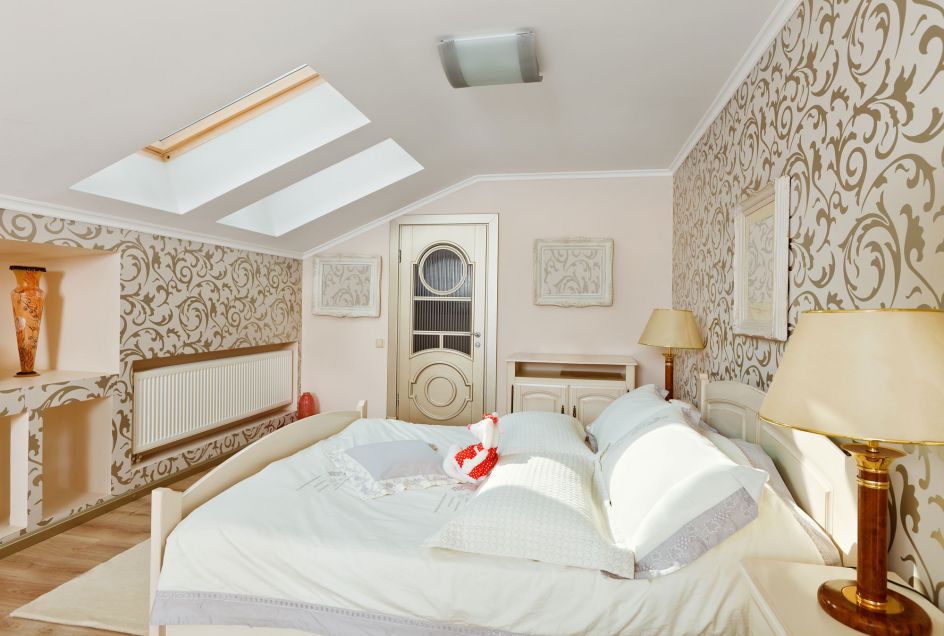
Experimental solutions for slanting ceilings/walls
How about approaching the whole concept like Salvador Dalí who liked to look at things from a surreal perspective. Create an experimental look by including a straight side wall in the design. The most important aspect here is the colour, which is why materials with special surface structures are particularly useful, for instance stunning cork wallpapers, plain-coloured textile models, crush and effect foil or leather-look wallpapers. One of the options is to wallpaper the entire sloped ceiling wall and half of an adjoining side wall with your favourite designer wall décor. The ceiling can be included, too. The remaining walls should be kept in a light colour or white.

Emphasise a sloping ceiling with a striking pattern motif
The slope proudly presented as a decorative feature wall that attracts the eye with striking pattern motifs - how about shining a light on it instead of wishing it wasn't there? Anything goes: shoes, cats, pouting lips, tropical rain forests, colourful birds of paradise, an ancestral portrait gallery or a collection of postcards, perfume bottles, comic heroes, peacocks, zebra skin, stylised flowers or lush bouquets. Check out our Shop to discover a plethora of exceptional wallpapers for sloped ceilings.
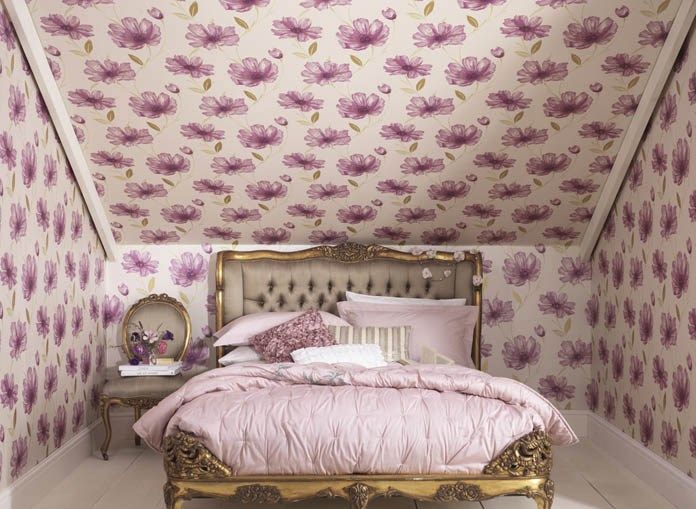
Wallpaper ideas for sloped ceilings and gable walls under the eaves
Beautiful patterned wallpapers featuring unusual materials, or imitation wood and stone models can create amazing rooms under the eaves.
Gable walls that are in the direct field of vision are particularly well suited for strong patterns like flowers, Baroque and Art Nouveau elements, romantic, nostalgic, and free-flowing geometric patterns or unusual pattern motifs. The sloped ceilings should feature a lighter colour taken from the pattern, but not have a pattern themselves.
Wood creates an ambience of well-being and comfort, imitation stone wallpapers provide urban flair. Sloped ceilings and gable walls can be adorned with the same design wallpaper, but always take into account the pattern size and the light situation in the room in question.
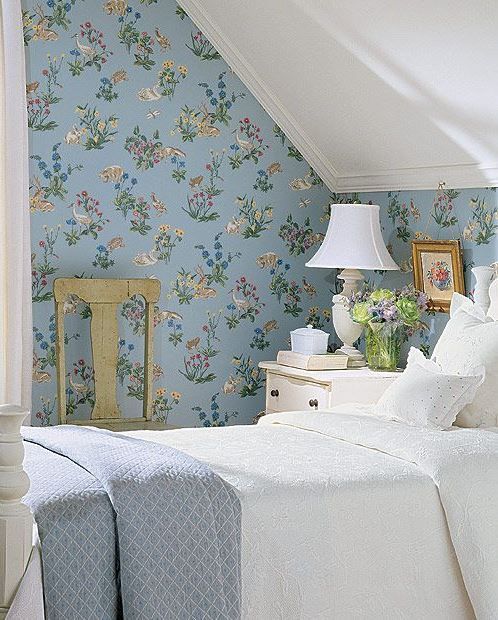
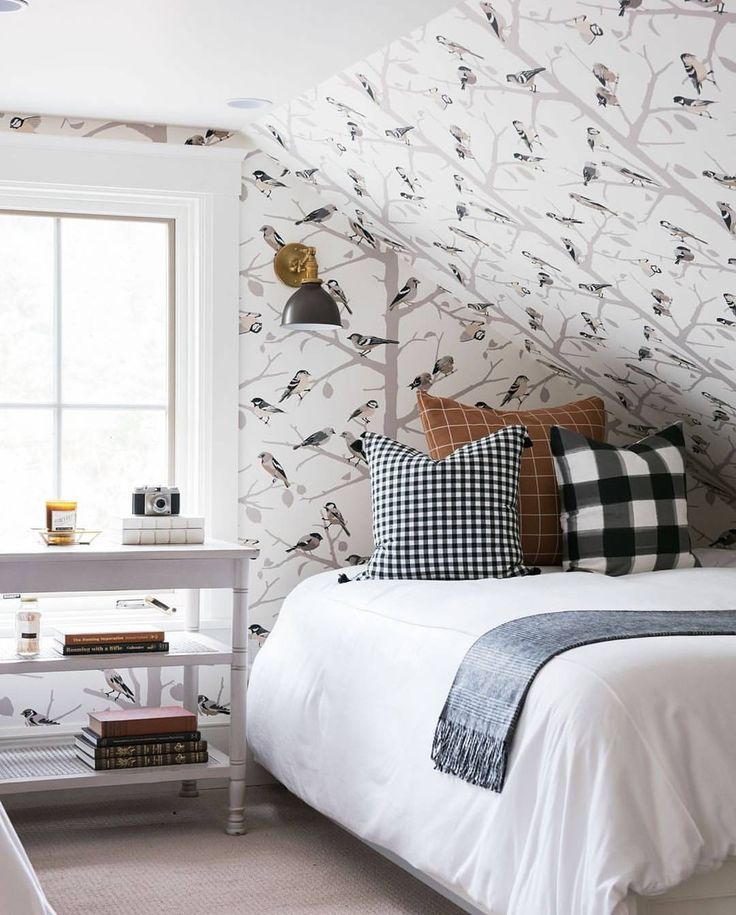
Alternatively, how about making the slope a feature and emphasise the non-linear room architecture. Simply select a vertical pattern as these are most suited for the sloped shape. For instance: triangular or diamond shapes, floral elements or dots. In terms of colours, lean towards lighter shades.
Wallpapering sloped ceilings (with knee walls)
It takes a little bit more finesse and patience to put wallpaper up on sloped ceilings, but even laymen can achieve fantastic results. Two methods are available: Either applying one strip of wallpaper to the full length or using two parts.
There is a stubborn theory that one shouldn't use just one length of wallpaper as it supposedly won't stick to the wall where the slope meets the knee wall, and because the process might result in air bubbles or dents. But this is only the case when it isn't done properly or the underground is uneven. Any craftsman will use one strip of wallpaper for these areas. Many prefer it as it avoids creating a cut which might cause issues with patterned wallpapers. Ultimately, it is up to individual preferences. However, in some cases, e.g. with specific materials (metal wallpapers) or very heavy models, putting the wallpaper up in two parts might be the more sensible solution.
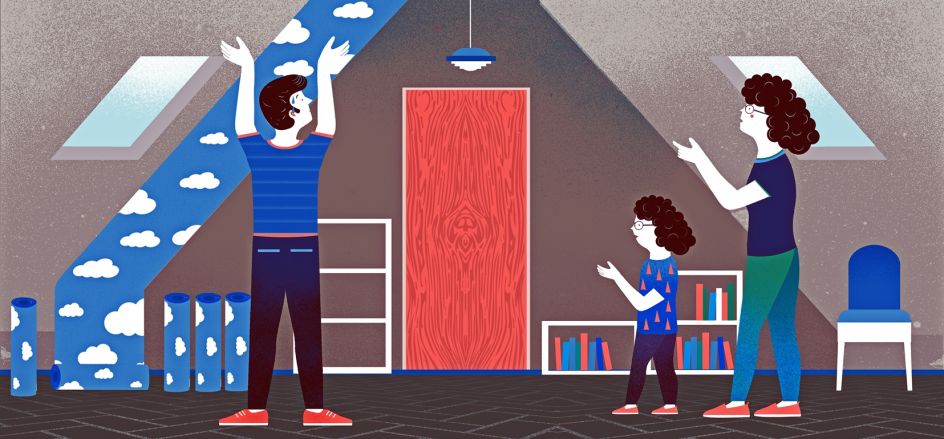
1. Using one length of wallpaper for the ceiling slope
Strips of wallpaper for sloped ceilings are longer than those for straight walls. Combined with the inclination and the height, this creates a somewhat more tricky initial situation. If you choose this option as a beginner or a layperson, you should find someone else to assist you.
When using non-woven wallpapers, the adhesive is applied directly to the wall and there is no soaking time. The wallpaper is set along the plumb line and moved a few centimetres over the ceiling or gable area. Move along the slope bit by bit, and brush the wallpaper onto the wall, allowing the air to escape towards the sides. Make sure that the lower part of the wallpaper strip doesn't touch the wall. The second person holds the wallpaper away from the pasted wall. If there are creases or larger air bubbles, carefully pull the wallpaper away from the wall in an upward movement and then smooth it out once more. If you pull off too much of the wallpaper strip, gravity comes into play and the whole thing could fall on the floor. Just be patient and do it slowly.
Paper-based wallpapers have to be soaked in adhesive paste first. The top third of the length of wallpaper is folded over, then the bottom two thirds are also folded over. After the required soaking time, you can climb up your stepladder with the folded wallpaper. Ideally, the second person holds the long folded area whilst you unfold the top end and begin the wallpapering process. As the paste has been applied to the wallpaper, it is obviously heavier than a dry length would be. Once you have put a length up, the person helping you can use a soft broom with a long stick (after carefully covering the brush with cling-film) as a support.
2. Using two parts of a length of wallpaper for the ceiling slope
An easier alternative for laypeople is applying the wallpaper in two parts. This requires a different approach when cutting the strips. Instead of measuring the entire length from ceiling to floor, it is measured from ceiling to knee wall (i.e. the area where the slope meets the straight wall), a few centimetres are added and the length is cut accordingly. The second partial length is measured from the top of the knee wall to the floor. As the patterns of both parts have to be matched exactly, it is important to hold the length up on the wall and calculate the accurate measurement this way before cutting. The cut piece is exactly matched to the one that is already in situ. This creates a small overhang which can be removed with a double seam cut.
Wallpapering tips for sloped ceilings
Here are some tips that help achieve the perfect results when wallpapering sloped ceilings:
- The most important aspect is a smooth, even underground. In old buildings, the angles of sloped ceilings aren't always straight and the surface might be uneven. But because even small issues are much more obvious in slope areas, a perfectly smooth surface is essential. If you'd rather avoid re-plastering or putting up plasterboard cladding, you should not choose a very thin wallpaper model; alternatively you could prepare the wall with a lining paper.
- Plasterboard slopes need a primer coat as otherwise they are too absorptive, which makes the wallpapering process extremely difficult and removing the wallpaper at a later date almost impossible.
- For heavier materials, dispersion glue should be added to the wallpaper paste to increase the adhesive strength.
- If the area where the slope meets the knee wall is curved (especially in older buildings), a flexible tape measure is much more suitable; small spirit levels should be used for the plumb line.
- The slanted area is always wallpapered first, followed by the adjoining straight walls.

